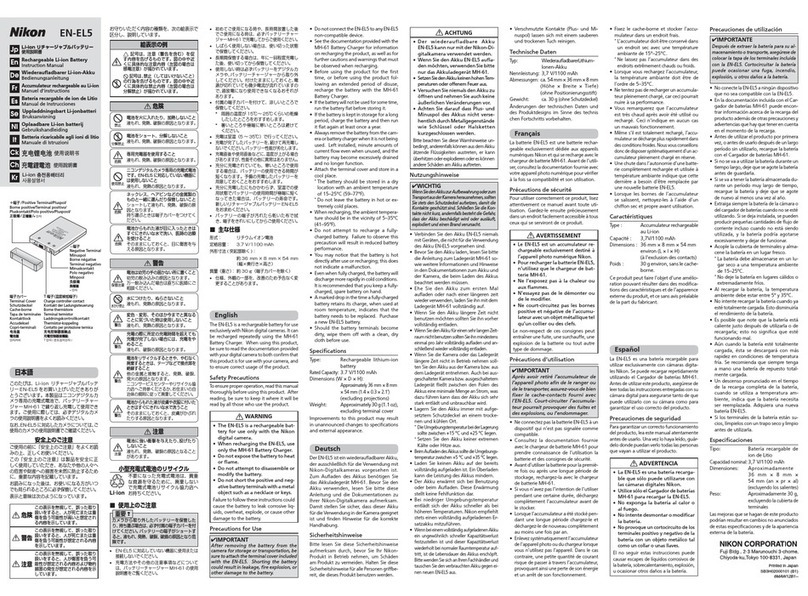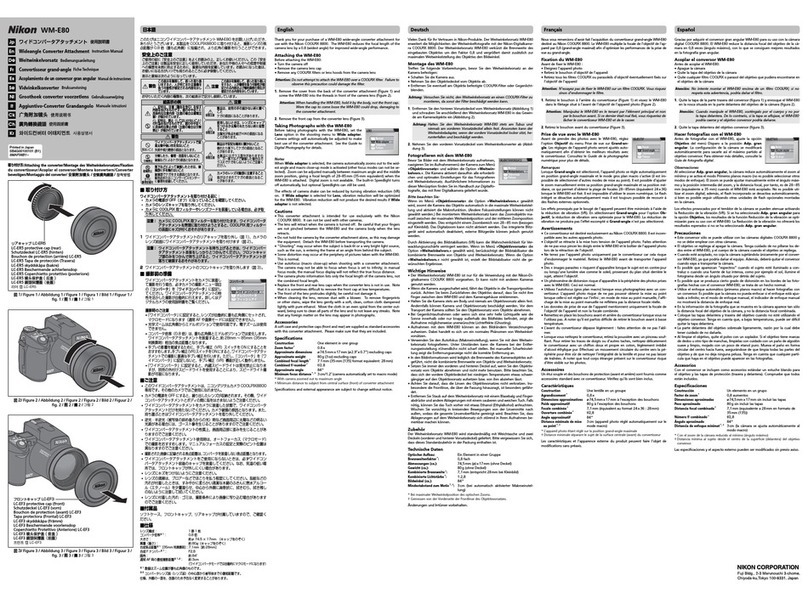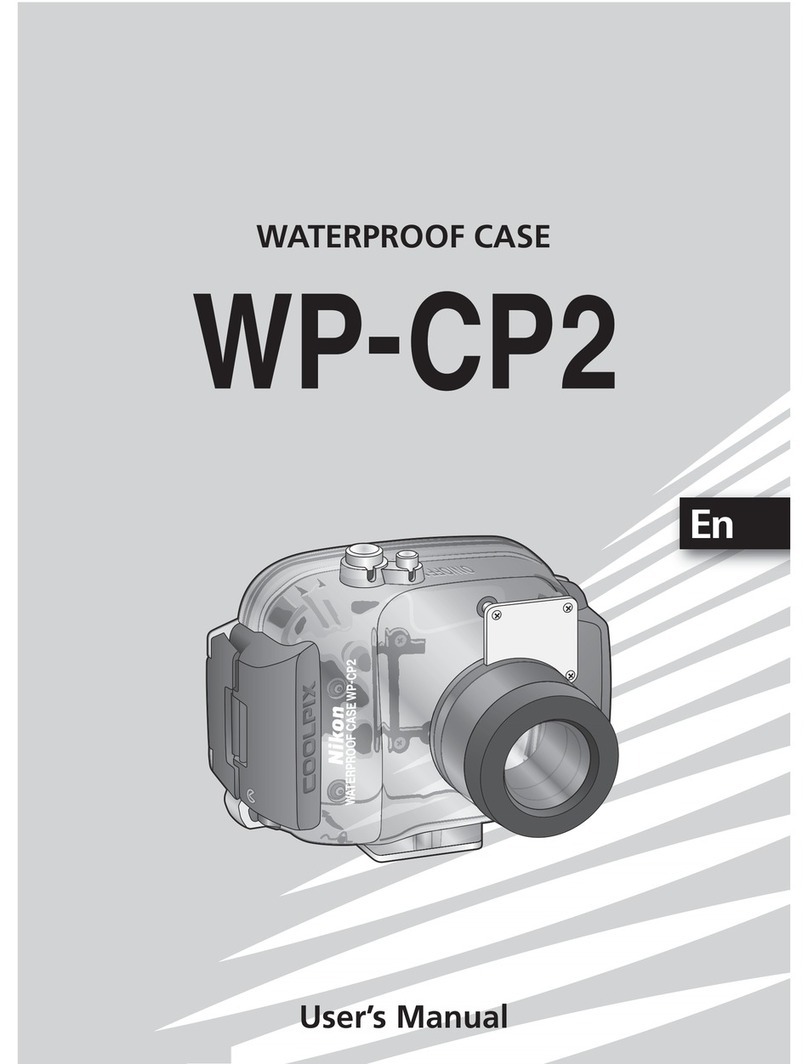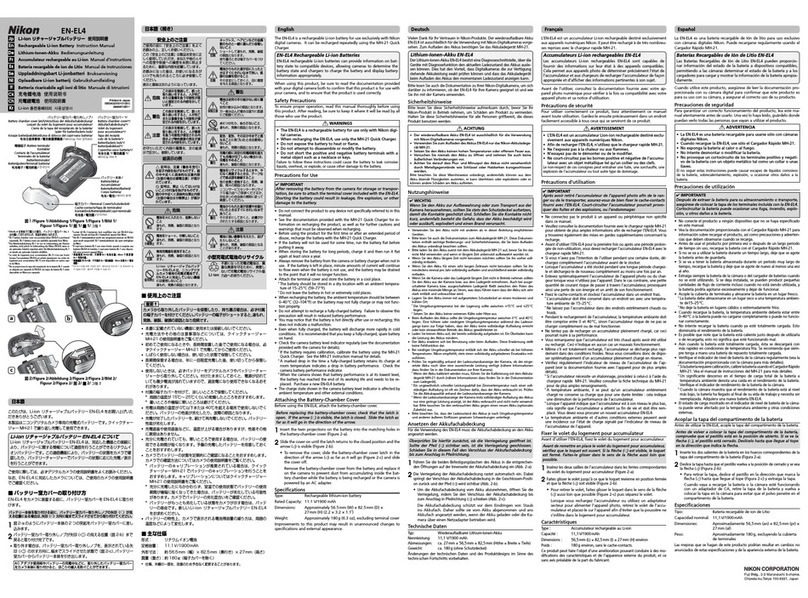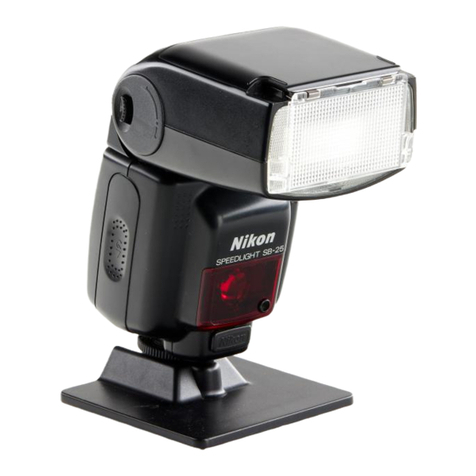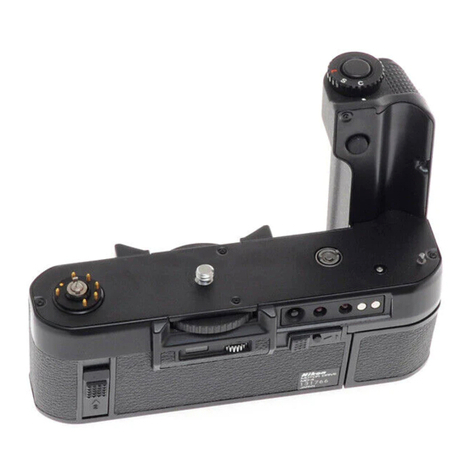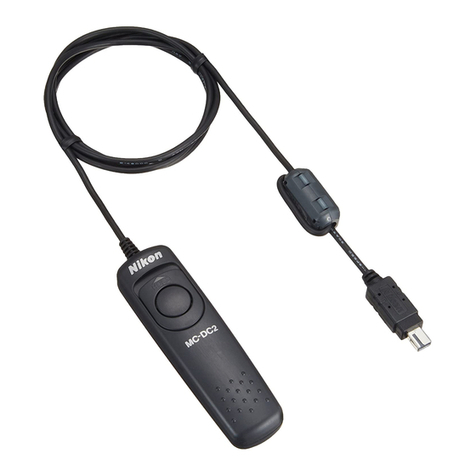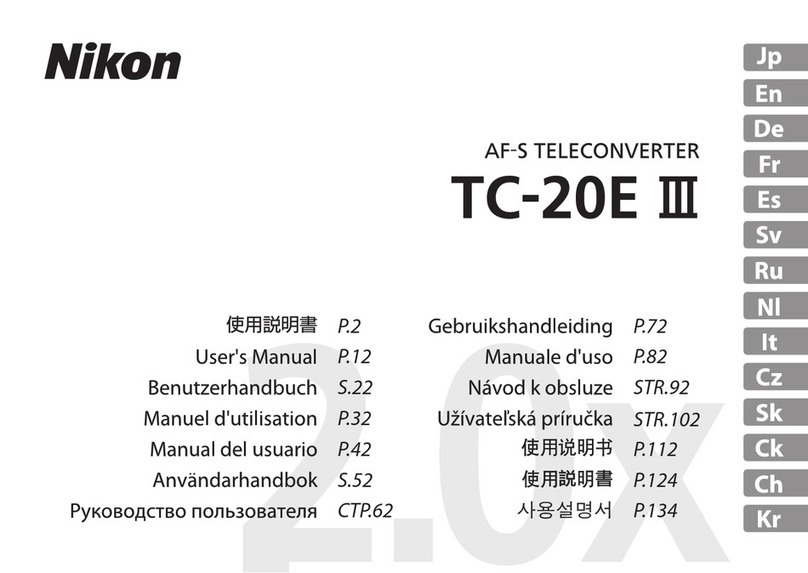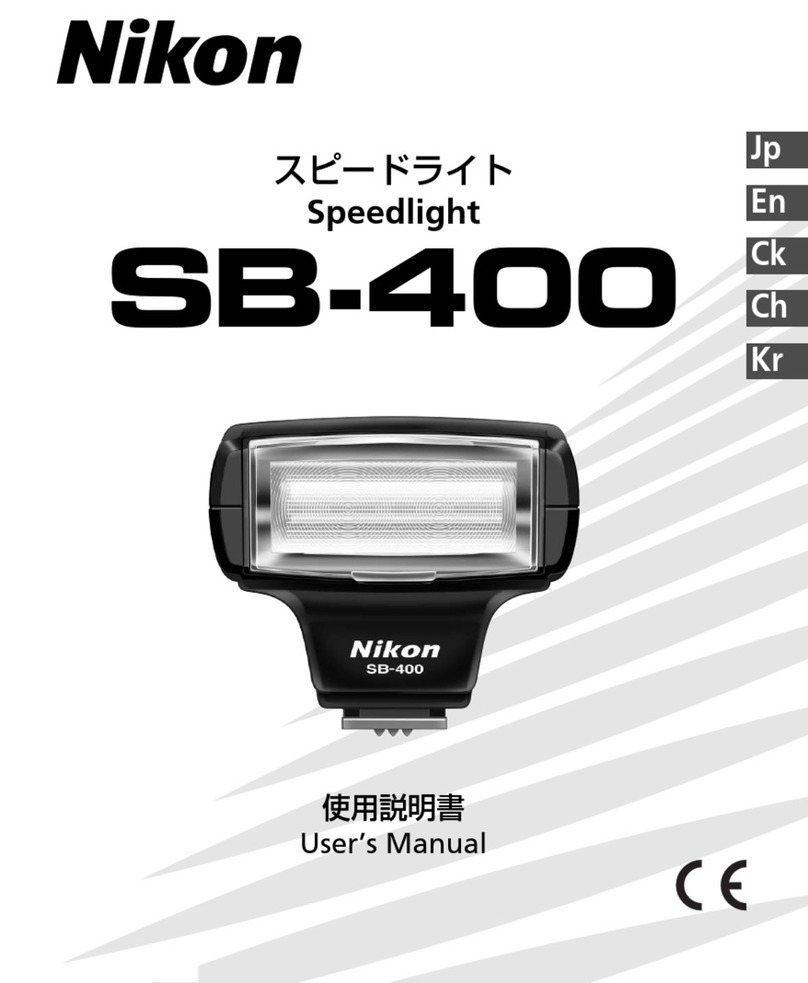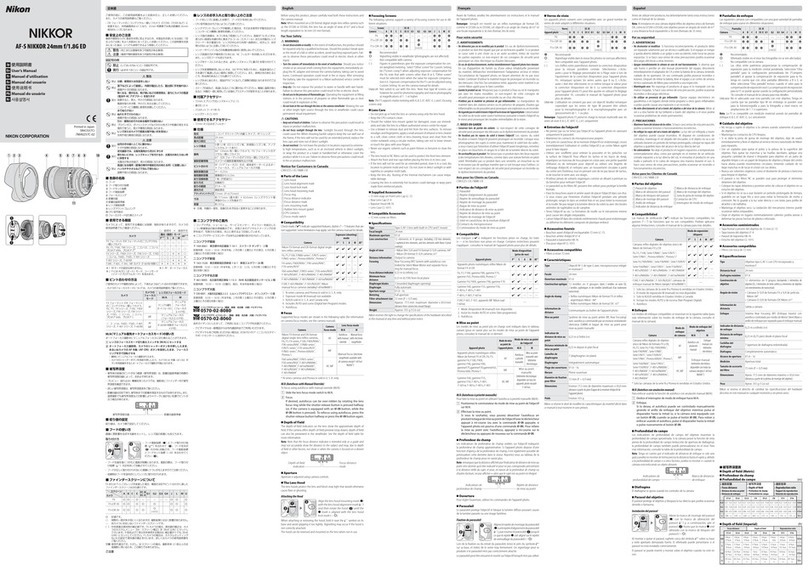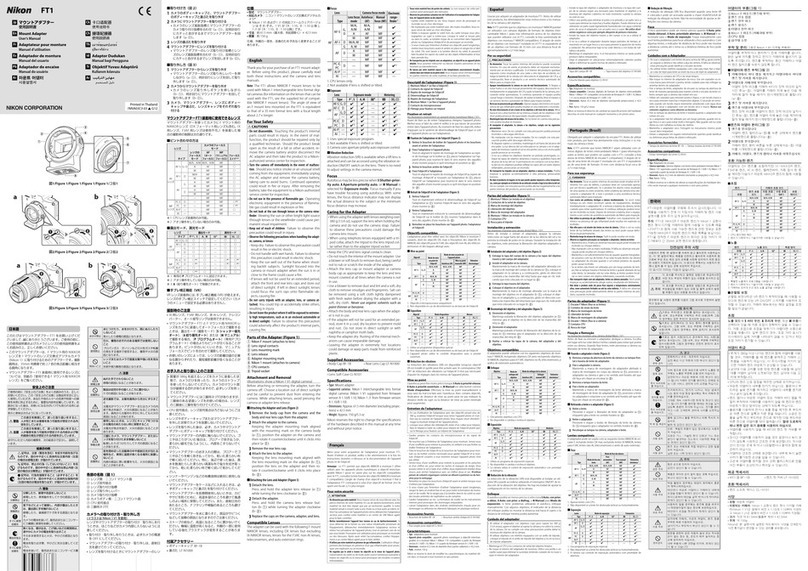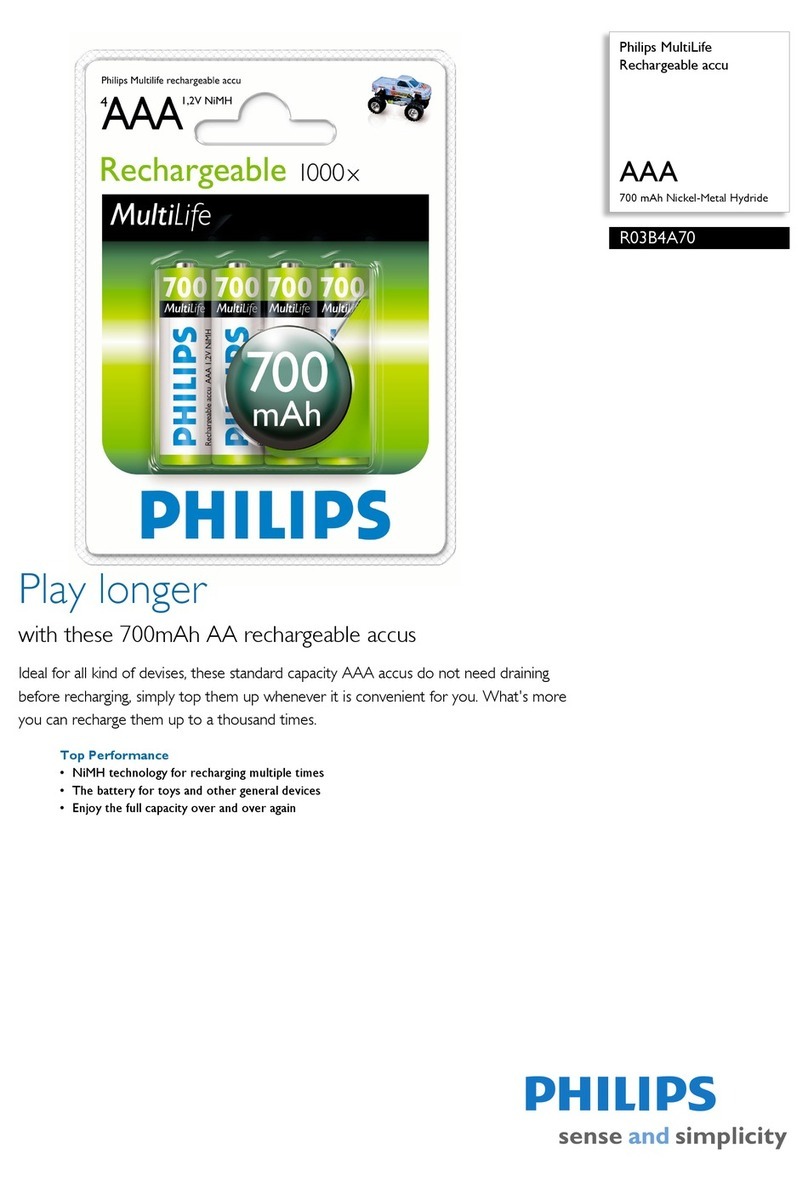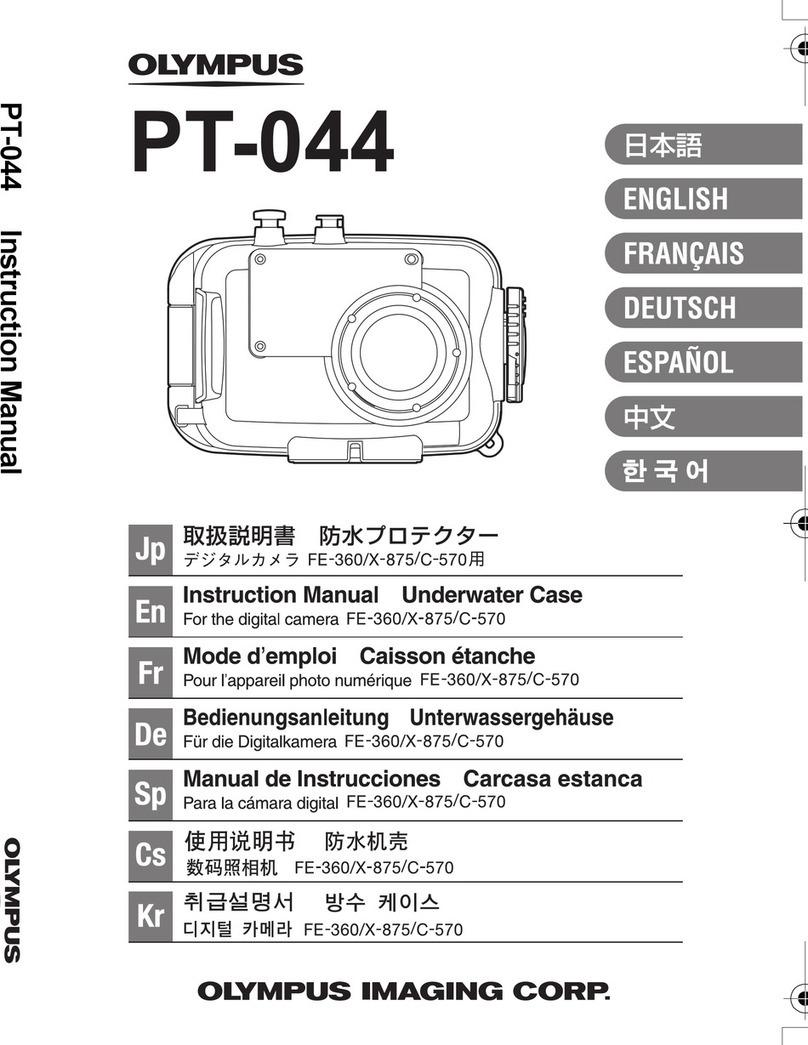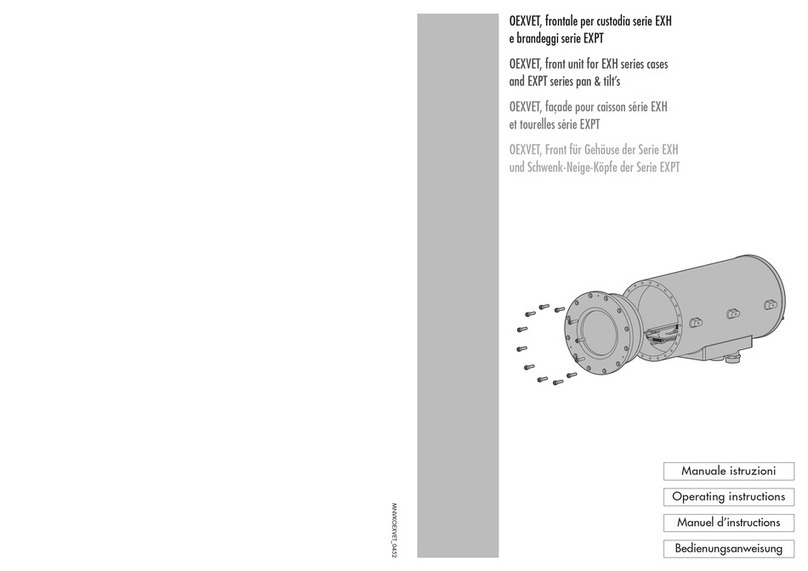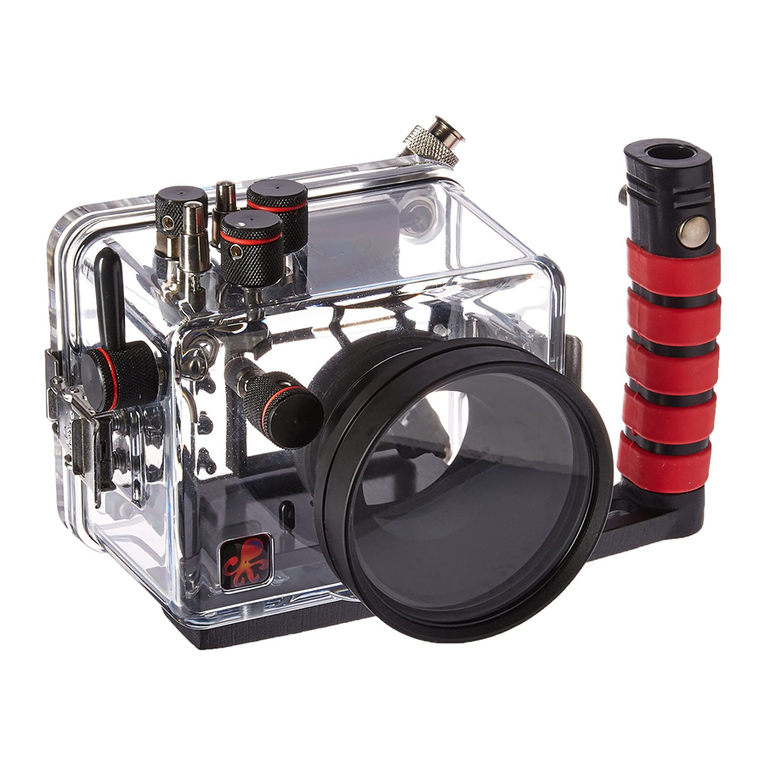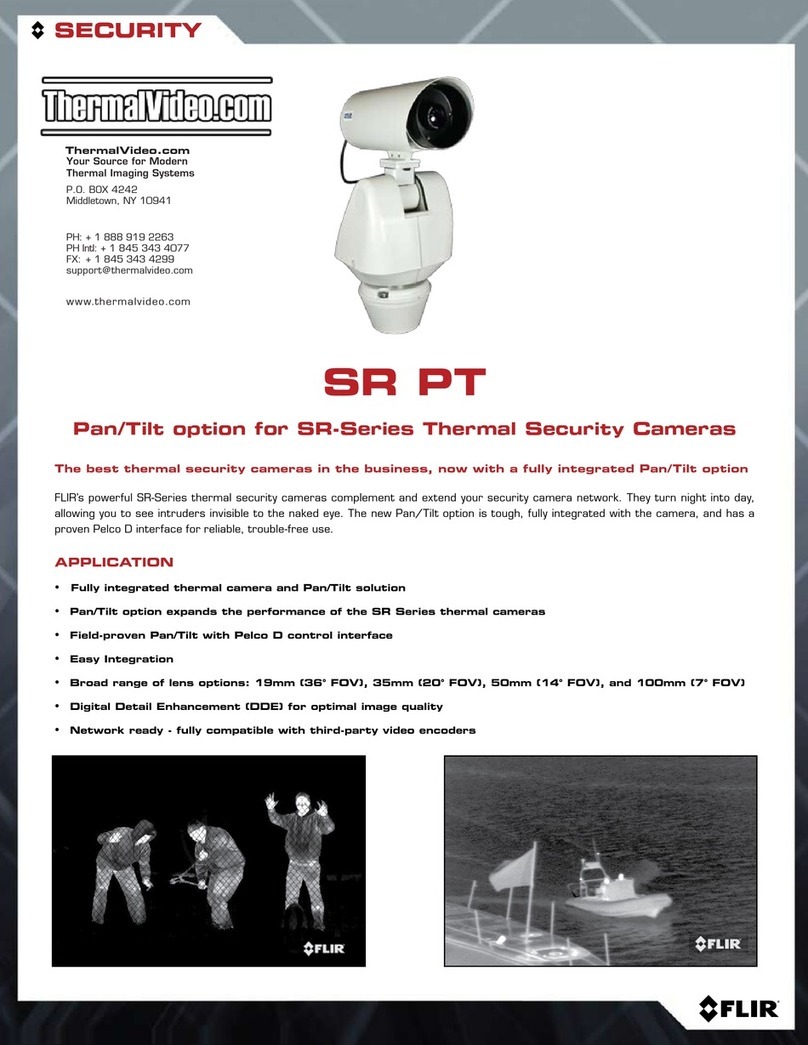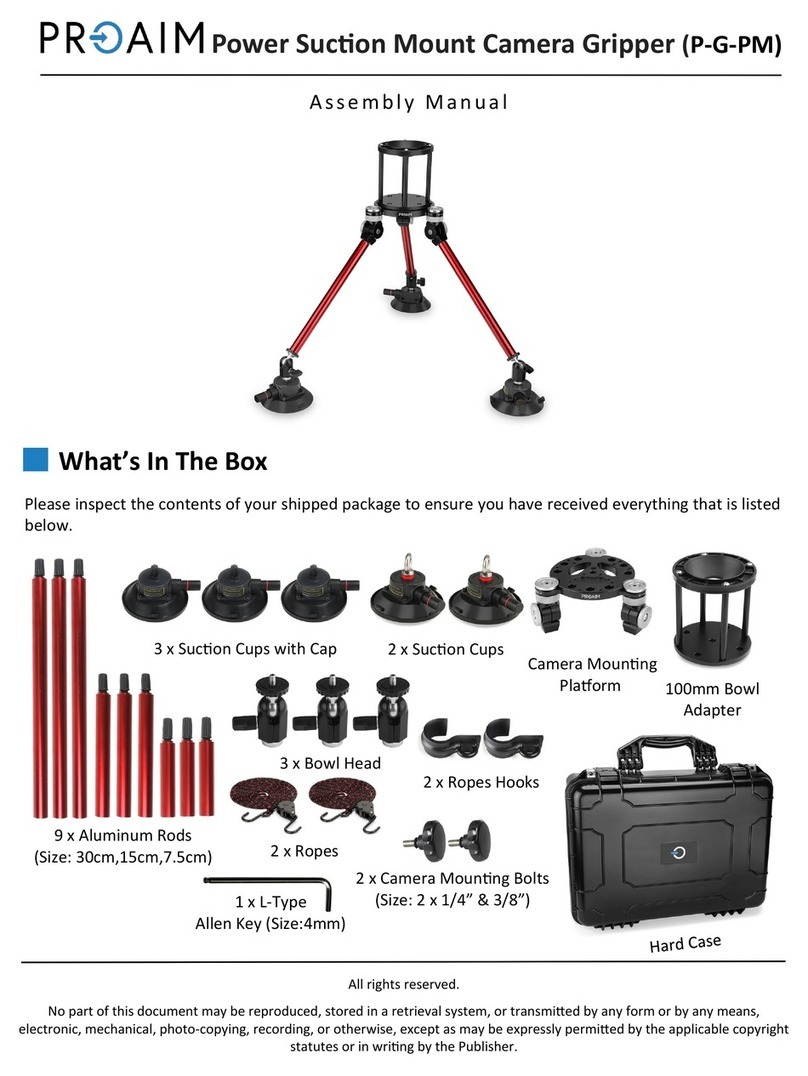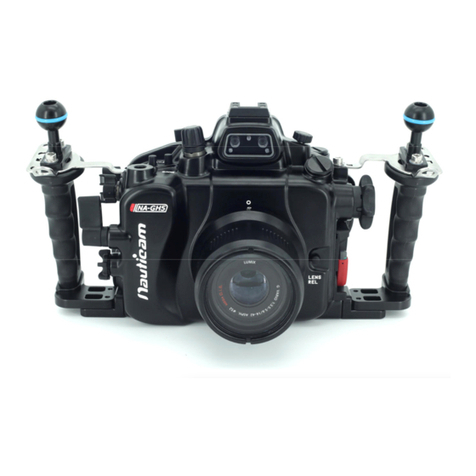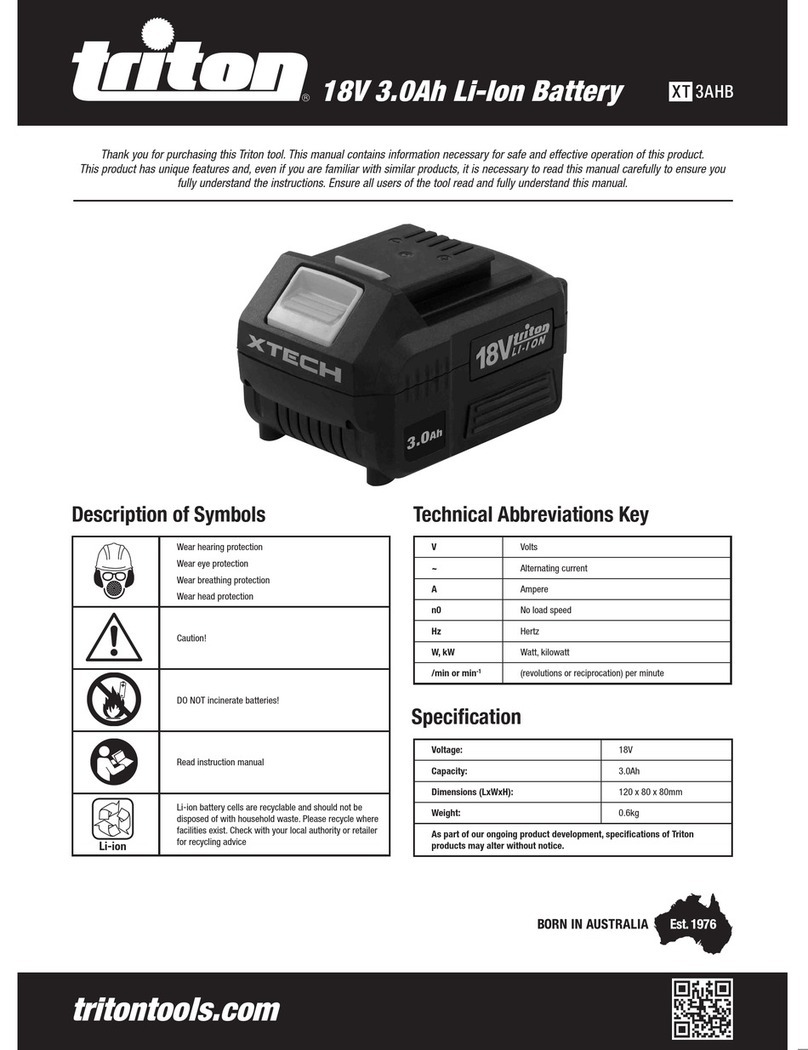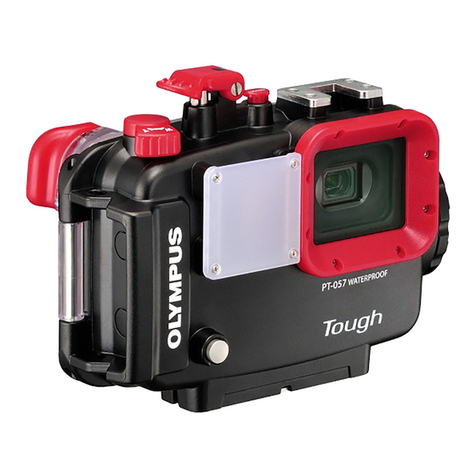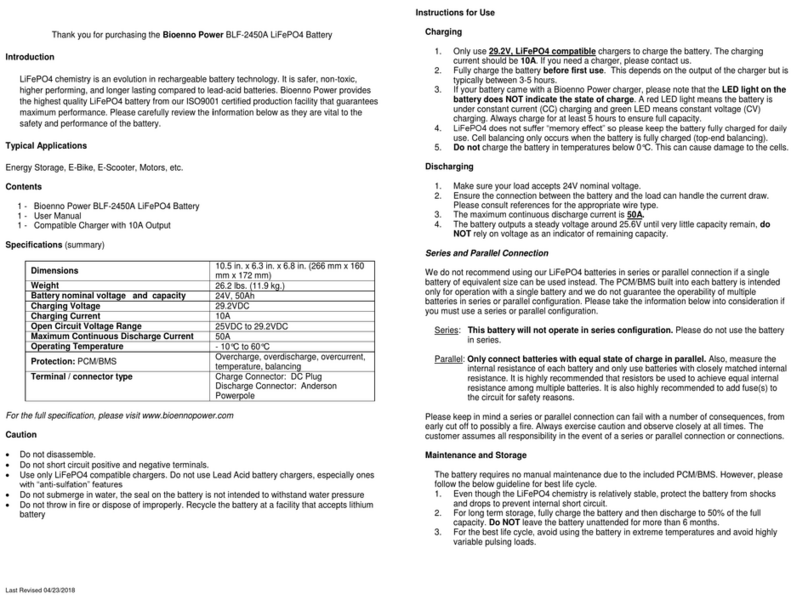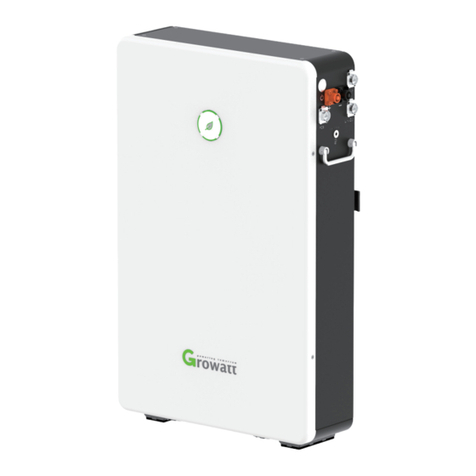Nikon AF-S DX NIKKOR 16-85mm f/3.5-5.6G ED VR User manual

AF-S DX NIKKOR
16-85mm f/3.5-5.6 ED VR
使用説明書 P. 2 Jp
User’s Manual Pg. 12 En
Benutzerhandbuch S. 22 De
Manuel d’utilisation P. 32 Fr
Manual del usuario Pág. 42 Es
Användarhandbok S. 52 Sv
Pykoводство пользoвaтеля СТР. 62 Ru
Gebruikshandleiding P. 72 Nl
Manuale d’uso Pag. 82 It
92 Ck
106 Ch
116 Kr
AF-S DX NIKKOR 16-85mm f/3.5-5.6 ED VR
使用説明書の内容が破損などによって判読できなくなったときは、
ニコンサービス機関にて新しい使用説明書をお求めください(有料)。
No reproduction in any form of this manual, in whole or in part (except for brief
quotation in critical articles or reviews), may be made without written authorization
from NIKON CORPORATION.
Printed in Thailand
7MAA43C2-05 ▲G02

2
Jp
En
De
Fr
Es
Se
Ru
Nl
It
Ck
Ch
Kr
安全上のご注意
ご使用の前に「安全上のご注意」をよくお読みのうえ、正しくお使いください。この「安全上のご注意」は製品を安
全に正しく使用していただき、あなたや他の人々への危害や財産への損害を未然に防止するために、重要な内容を記
載しています。お読みになった後は、お使いになる方がいつでも見られる所に必ず保管してください。
表示について
表示と意味は次のようになっています。
お守りいただく内容の種類を、次の絵表示で区分し、説明しています。
絵表示の例
警告 この表示を無視して、誤った取り扱いをすると、人が死亡または重傷を負う可能性が想定される内容を
示しています。
注意 この表示を無視して、誤った取り扱いをすると、人が傷害を負う可能性が想定される内容および物的損
害の発生が想定される内容を示しています。
記号は、注意(警告を含む)を促す内容を告げるものです。図の中や近くに具体的な注意内容(左図の場合は
感電注意)が描かれています。
記号は、禁止(してはいけないこと)の行為を告げるものです。図の中や近くに具体的な禁止内容(左図の場
合は分解禁止)が描かれています。
記号は、行為を強制すること(必ずすること)を告げるものです。図の中や近くに具体的な強制内容(左図の
場合は電池を取り出す)が描かれています。

3
Jp
En
De
Fr
Es
Se
Ru
Nl
It
Ck
Ch
Kr
警告
分解禁止
分解したり修理・改造をしないこと
感電したり、異常動作をしてケガの原因となります。
接触禁止
すぐに修理
依頼を
落下などによって破損し、内部が露出したときは、
露出部に手を触れないこと
感電したり、破損部でケガをする原因となります。
カメラの電池を抜いて、販売店またはニコンサー
ビス機関に修理を依頼してください。
電池を取る
すぐに修理
依頼を
熱くなる、煙が出る、こげ臭いなどの異常時は、速
やかにカメラの電池を取り出すこと
そのまま使用すると火災、やけどの原因となりま
す。電池を取り出す際、やけどに十分注意してくだ
さい。電池を抜いて、販売店またはニコンサービス
機関に修理を依頼してください。
水かけ禁止
水につけたり水をかけたり、雨にぬらしたりしな
いこと
発火したり感電の原因となります。
使用禁止
引火・爆発のおそれのある場所では使用しないこと
プロパンガス・ガソリンなど引火性ガスや粉塵の
発生する場所で使用すると、爆発や火災の原因と
なります。
見ないこと
レンズまたはカメラで直接太陽や強い光を見ない
こと
失明や視力障害の原因となります。
注意
感電注意
ぬれた手でさわらないこと
感電の原因になることがあります。
放置禁止
製品は幼児の手の届かないところに置くこと
ケガの原因になることがあります。
使用注意
逆光撮影では、太陽を画角から十分にずらすこと
太陽光がカメラ内部で焦点を結び、火災の原因に
なることがあります。画角から太陽をわずかに外
しても火災の原因になることがあります。
保管注意
使用しないときは、レンズにキャップをつけるか
太陽光のあたらない所に保管すること
太陽光が焦点を結び、火災の原因になることがあ
ります。
移動禁止
三脚にカメラやレンズを取り付けたまま移動しな
いこと
転倒したりぶつけたりしてケガの原因になること
があります。
放置禁止
窓を閉め切った自動車の中や直射日光が当たる場
所など、異常に温度が高くなる場所に放置しない
こと
内部の部品に悪い影響を与え、火災の原因となる
ことがあります。

4
Jp
En
De
Fr
Es
Se
Ru
Nl
It
Ck
Ch
Kr
各部の名称
( ):参照頁
M/A M
ON
OFF
NORMAL
ACTIV E
M/A M
ON
OFF
NORMAL
ACTIVE
D
A
C
B
1フード(P. 9)
2フード取り付け指標(P. 9)
3フードセット指標(P. 9)
4フード着脱指標(P. 9)
5ズームリング(P. 5)
6焦点距離目盛
7焦点距離目盛指標
8距離目盛
9距離目盛基準線
0フォーカスリング(P. 6)
aレンズ着脱指標
bレンズマウントゴムリング
(P. 9)
cCPU信号接点(P. 9)
dフォーカスモード切り換え
スイッチ(P. 6)
e手ブレ補正スイッチ(P. 7)
f手ブレ補正モード切り換え
スイッチ(P. 7)

5
Jp
En
De
Fr
Es
Se
Ru
Nl
It
Ck
Ch
Kr
このたびはDXニッコールレンズをお買い上げいただきありがとうございます。このレンズは、ニコンDXフォーマッ
トのニコンデジタル一眼レフカメラ(D300、D90など)専用です。
ニコンDXフォーマットでの撮影画角は、35mm判換算で焦点距離の約1.5倍の焦点距離に相当する画角になります。
ご使用の前に、この「使用説明書」をよくお読みの上、正しくお使いください。また、カメラの使用説明書もご覧く
ださい。
主な特長
・手ブレ補正機能(VR II)を使用すると、使わないと
きと比べ約4段分※シャッタースピードを遅くして撮
影できるため、シャッタースピードの選択範囲が広が
り、幅広い領域で手持ち撮影が可能です。(※当社測
定条件によります。また、手ブレ補正効果は、撮影者
や撮影条件によって異なります。)
・レンズ内超音波モーター(サイレント・ウェーブ・
モーター)を採用し静かなAF(オートフォーカス)撮
影が可能です。また、フォーカスモード切り換えス
イッチdによりAF(オートフォーカス)撮影および
MF(マニュアルフォーカス)撮影ができます。
・被写体までの距離情報をカメラボディー側に伝達す
る機能を備え、3Dマルチパターン測光機能を持った
カメラとの組み合わせ時には、より的確な露出制御を
実現します。
・ニコン独自の ED レンズ(特殊低分散)ガラスによる
色収差の補正とともに、非球面レンズや良好なボケ味
を再現する円形絞りの採用によりすぐれた光学性能、
描写性能を発揮します。
ズーミングと被写界深度
撮影を行う場合は、ズームリング5を回転させ(焦点距
離が変化します)構図を決めてから、ピント合わせを
行ってください。プレビュー(絞り込み)機構を持つカ
メラでは、撮影前に被写界深度を確認できます。
・このレンズは内焦方式を採用しています。ニコン内焦
方式は、通常のレンズと異なるため、至近距離になる
と焦点距離が若干短くなります。
・距離目盛は目安であり、被写体までの距離を保証する
ものではありません。また、遠景撮影でも被写界深度
などの影響により∞マークに届かない位置でピント
が合う場合があります。

6
Jp
En
De
Fr
Es
Se
Ru
Nl
It
Ck
Ch
Kr
ピント合わせの方法(図A)
ご使用のカメラや撮影目的によって、下表のようなピン
ト合わせが選択できます。
M/A(マニュアル優先オートフォーカス)モード
の使い方
1
レンズのフォーカスモード切り換えスイッチ dを
[M/A]にセットします。
2
オートフォーカス撮影時、シャッターボタンを半押
ししたまま、あるいはAF 作動ボタンを保持したま
ま、フォーカスリングを手で回転させると、瞬時に
マニュアルフォーカス撮影が行えます。
3
シャッターボタンの半押しや AF 作動ボタンを再度
操作するとAFで撮影が可能となります。
オートフォーカスが苦手な被写体について
「広角・超広角レンズのオートフォーカス撮影について」
(P. 11)をご覧ください。
手ブレ補正機能(VR II)
手ブレ補正機能の概念図
NORMALモードで対応
ACTIVEモードで対応
手ブレ補正
パンニング(流し撮り)での手ブレ補正
激しい揺れでの手ブレ補正
カメラの
フォーカス
モード
レンズの設定モード
M/A M
AF
マニュアル優先
オートフォーカス撮影
マニュアルフォーカス撮影
(フォーカスエイド可)
M
マニュアルフォーカス撮影(フォーカスエイド可)
NORMALモードまたはACTIVEモードで対応
NORMALモードで対応
ACTIVEモードで対応
手ブレ
パンニング
(流し撮り)
激しい揺れ
例)乗り物等
での揺れ
高
周
波
数
振 幅 大

7
Jp
En
De
Fr
Es
Se
Ru
Nl
It
Ck
Ch
Kr
手ブレ補正スイッチの使い方(図B)
ON: シャッターボタンを半押しすると、手ブレ
を補正します。ファインダー内の画像のブ
レも補正するため、ピント合わせが容易で、
フレーミングしやすくなります。
OFF: 手ブレを補正しません。
手ブレ補正モード切り換えスイッチの使い方(図
C
)
NORMAL: 主に、通常の手ブレを補正します。パンニ
ングに対応し、流し撮りも行えます。
ACTIVE: 乗り物に乗っている等、揺れの激しい条件
でのブレから通常の手ブレを補正します。
このモードではパンニング自動検出は行い
ません。
手ブレ補正使用時のご注意
・シャッターボタンを半押し後、ファインダー像が安定
してから撮影することをおすすめします。
・流し撮りする場合は、必ず NORMAL モードにしてく
ださい。NORMALモードでは、流し撮りなどでカメ
ラの向きを大きく変えた場合、流した方向の手ブレ補
正は機能しません。例えば、流し撮りで横方向にパン
ニングすると、縦方向の手ブレだけが補正され、流し
撮りが行えます。
・手ブレ補正の原理上、シャッターレリーズ後にファイ
ンダー像がわずかに動くことがありますが、異常では
ありません。
・手ブレ補正中にカメラの電源スイッチを OFF にした
り、レンズを取り外したりしないでください。(その
状態でレンズを振るとカタカタ音がすることがあり
ますが、故障ではありません。カメラの電源スイッチ
を再度ONにすれば、音は消えます。)
・内蔵フラッシュ搭載のカメラで、内蔵フラッシュ充電
中には、手ブレ補正は行いません。
・
三脚を使用するときは、手ブレ補正スイッチ
e
を[
OFF
]
にしてください。ただし、三脚を使っても雲台を固定し
ないときや、一脚を使用するときには、スイッチを[
ON
]
にすることをおすすめします。
・AF 作動ボタンのあるカメラ(D2 シリーズ、D300 な
ど)で、AF作動ボタンを押しても、手ブレ補正は作
動しません。

8
Jp
En
De
Fr
Es
Se
Ru
Nl
It
Ck
Ch
Kr
絞り値の設定
絞り値を設定する場合は、カメラで設定してください。
開放F値の変化
このレンズはズーミングにより、開放 F値が最大11/3段
変化します。ただし、露出を決める際に、F値の変化量
はカメラが自動的に補正しますので考慮する必要はあ
りません。
カメラの内蔵フラッシュ使用時のケラレに
ついて
・ケラレ(写真の一部に影ができる)を防止するため、
レンズフード1は取り外して使用してください。
・撮影距離0.6m未満では使用できません。
D300/D200/D90/D80/D50の内蔵フラッシュは、
18mmレンズの画角をカバーする照射角で、D100の内
蔵フラッシュは、20mmレンズの画角をカバーする照
射角なので、焦点距離16mmでは周辺が暗くなります。
デジタル
一眼レフカメラ
ケラレなく撮影できる焦点距離と
撮影距離
D300S
•焦点距離16mmでは撮影距離0.7m
以上。
•焦点距離24mm以上は制約なし。
D300/D200 •焦点距離16mm以上は制約なし。
D100
•焦点距離16mmでは撮影距離1.0m
以上。
•焦点距離24mm以上は制約なし。
D90/D80/D50
•焦点距離16mmでは撮影距離2.0m
以上。
•焦点距離24mm以上は制約なし。
D3100/D3000/
D70シリーズ/
D60/D40シリーズ
•焦点距離24mm以上は制約なし。

9
Jp
En
De
Fr
Es
Se
Ru
Nl
It
Ck
Ch
Kr
バヨネットフード
HB-39
の取り付け、取り外し
取り付け方
レンズ先端のフード着脱指標4とフード取り付け指標
(、
2ヶ所のいずれか)2を合わせ、カメラ側から見
て反時計回りにカチッと音がするまでフード1を回転
させ、確実に取り付けます。(図D)
・フード着脱指標とフードセット指標( )3が合っ
ていることを確認してください。
・フードが正しく取り付けられないと撮影画面にケラ
レを生じますのでご注意ください。
・フード先端を強くつかむと着脱が困難になります。着
脱の際は、フードの根元(フード取り付け指標部分)
付近を持って回転させてください。
取り外し方
フードの根元(フード取り付け指標部分)付近を持ち、
カメラ側から見て時計回りにフードを回転させて取り
外します。
レンズのお手入れと取り扱い上のご注意
・レンズの CPU 信号接点 cは汚さないようにご注意く
ださい。
・レンズマウントゴムリング bが破損した場合は、そ
のまま使用せず修理を依頼してください。
・レンズ面の清掃は、ホコリを拭う程度にしてくださ
い。指紋がついたときは、柔らかい清潔な木綿の布に
無水アルコール(エタノール)または市販のレンズク
リーナーを少量湿らせ、レンズの中心から外周へ渦巻
状に、拭きムラ、拭き残りのないように注意して拭い
てください。
・シンナーやベンジンなどの有機溶剤は絶対に使用し
ないでください。
・
レンズ表面の汚れや傷を防ぐためには、
NC
フィルター
をお使いいただけます。また、レンズフード
1
も役立
ちます。
・レンズをソフトケースに入れるときは、必ずレンズ
キャップと裏ぶたを取り付けてください。なお、フー
ド1を逆向きにしてレンズに取り付けた状態でも収
納可能です。
・フード 1を持ってカメラを持ち上げたりしないでく
ださい。
・レンズを長期間使用しないときは、カビやサビを防ぐ
ために、高温多湿のところを避けて風通しのよい場所
に保管してください。また、直射日光のあたるところ、
ナフタリンや樟脳のあるところも避けてください。
・レンズを水に濡らすと、部品がサビつくなどして故障
の原因となりますのでご注意ください。
・
ストーブの前など、高温になるところに置かないでく
ださい。極端に温度が高くなると、外観の一部に使用し
ている強化プラスチックが変形することがあります。

10
Jp
En
De
Fr
Es
Se
Ru
Nl
It
Ck
Ch
Kr
付属アクセサリー
・67mmスプリング式レンズキャップ LC-67
・裏ぶた
・バヨネットフード HB-39
・ソフトケース CL-1015
別売アクセサリー
・67mmネジ込み式フィルター
使用できないアクセサリー
・テレコンバーター:全種類
・オート接写リング:PKリング全種類
・Kリング:全種類
・オートリング BR-4
・ベローズアタッチメント:全種類
・アタッチメントリング SX-1
※その他のアクセサリーでも、使用できない場合があり
ます。アクセサリーの使用説明書をご確認ください。
仕 様
・仕様、外観の一部を、改善のため予告なく変更するこ
とがあります。
型式 ニコンFマウントCPU内蔵Gタイプ、
AF-S DXニッコールズームレンズ(ニ
コンデジタル一眼レフカメラ[ニコン
DXフォーマット]専用)
焦点距離 16mm―85mm
最大口径比 1:3.5―5.6
レンズ構成
11
群
17
枚(非球面レンズ
3
枚、
ED
レンズ
2
枚)
画角 83°―18°50′
焦点距離目盛 16、24、35、50、70、85mm
撮影距離情報
カメラボディーへの撮影距離情報出力可能
ズーミング ズームリングによる回転式
ピント合わせ IF(ニコン内焦)方式、超音波モー
ターによるオートフォーカス、マニュ
アルフォーカス可能
手ブレ補正 ボイスコイルモーター(VCM)による
レンズシフト方式
撮影距離目盛 ∞〜0.38m
最短撮影距離 0.38 m(ズーム全域)
絞り羽根枚数 7枚(円形絞り)
絞り方式 自動絞り
絞りの範囲 焦点距離16mm時f/3.5―22、
85mm時f/5.6―36
測光方式 開放測光
アタッチメントサイズ
67 mm(P=0.75 mm)
大きさ
約
72 mm
(最大径)×
85 mm
(バヨネット
マウント基準面からレンズ先端まで)
質量 約485 g

11
Jp
En
De
Fr
Es
Se
Ru
Nl
It
Ck
Ch
Kr
広角・超広角レンズのオートフォーカス撮影について
広角・超広角レンズでは、標準クラスのレンズと比べ、下記のような撮影条件になりやすく、オートフォーカス撮影
時には注意が必要です。
以下をお読みになって、オートフォーカス撮影にお役立てください。
1. フォーカスフレームに対して主要な被写体が
小さい場合
図Eのように、フォーカスフレーム内に遠くの建物と
近くの人物が混在するような被写体になると、背景
にピントが合い、人物のピント精度が低下する場合
があります。
2. 絵柄がこまかな場合
図Fのように、被写体が小さいか、明暗差が少ない被
写体になると、オートフォーカスにとっては苦手な
被写体になります。
◆このような時には・・・
1、2のような被写体条件でオートフォーカスが上手く働
かない場合、主要被写体とほぼ同じ距離にある被写体で
フォーカスロックし、構図を元に戻して撮影する方法が
有効です。
また、マニュアルフォーカスに切り換えて、マニュアル
でピントを合わせて撮影する方法もあります。
その他
お手持ちのカメラボディーの使用説明書で「オート
フォーカスが苦手な被写体について」の説明も参照して
ください。
E〈人物〉
F〈花畑〉

12
Jp
En
De
Fr
Es
Se
Ru
Nl
It
Ck
Ch
Kr
Notes on Safety Operations
CAUTION
Do not disassemble
Touching the internal parts of the camera or lens could
result in injury. Repairs should be performed only by
qualified technicians. Should the camera or lens break
open as the result of a fall or other accident, take the
product to a Nikon-authorized service representative for
inspection after unplugging the product and/or removing
the battery.
Turn off immediately in the event of malfunction
Should you notice smoke or an unusual smell coming from
the camera or lens, remove the battery immediately, taking
care to avoid burns. Continued operation could result in
injury.
After removing or disconnecting the power source, take
the product to a Nikon-authorized service representative
for inspection.
Do not use the camera or lens in the presence of
flammable gas
Operating electronic equipment in the presence of
flammable gas could result in an explosion or fire.
Do not look at the sun through the lens or viewfinder
Viewing the sun or other strong light sources through the
lens or viewfinder could cause permanent visual
impairment.
Keep out of reach of children
Particular care should be taken to prevent infants from
putting the batteries or other small parts into their mouths.
Observe the following precautions when handling
the camera and lens
• Keep the camera and lens unit dry. Failure to do so could
result in fire or electric shock.
• Do not handle or touch the camera or lens unit with wet
hands. Failure to do so could result in electric shock.
• When shooting with back-lighting, do not point the lens
at the sun or allow sunlight to pass directly down the lens
as this may cause the camera to overheat and possibly
cause a fire.
• When the lens will not be used for an extended period of
time, attach both front and rear lens caps and store the
lens away from direct sunlight. Failure to do so could
result in a fire, as the lens may focus sunlight onto a
flammable object.

13
Jp
En
De
Fr
Es
Se
Ru
Nl
It
Ck
Ch
Kr
Nomenclature ( ) : reference page
M/A M
ON
OFF
NORMAL
ACTIV E
M/A M
ON
OFF
NORMAL
ACTIVE
D
A
C
B
1
Lens hood (P. 18)
2Lens hood attachment index
(P. 18)
3Lens hood setting index
(P. 18)
4Lens hood mounting index
(P. 18)
5Zoom ring (P. 15)
6Focal length scale
7Focal length index
8Distance scale
9Distance index line
0Focus ring (P. 15)
aMounting index
bLens mount rubber gasket
(P. 19)
cCPU contacts (P. 19)
dFocus mode switch (P. 15)
eVibration reduction ON/OFF
switch (P. 16)
fVibration reduction mode
switch (P. 16)

14
Jp
En
De
Fr
Es
Se
Ru
Nl
It
Ck
Ch
Kr
Thank you for purchasing the AF-S DX NIKKOR 16-85mm f/3.5-5.6G ED VR lens. DX Nikkor lenses are specially
designed for use with Nikon digital-SLR (Nikon DX format) cameras, such as the D300 and D90. When mounted on
Nikon DX format cameras, the lens picture angle is equivalent to approximately 1.5×the focal length in 35mm
format. Before using this lens, please read these instructions and refer to your camera’s User’s Manual.
Major features
• By enabling vibration reduction (VR II), slower shutter
speeds (approximately four stops*) can be used, thus
increasing the range of usable shutter speeds and
zoom positions, particularly when hand-holding the
camera. (*Based on results achieved under Nikon
measurement conditions. The effects of vibration
reduction may vary according to shooting conditions
and use.)
• This lens employs a Silent Wave Motor to drive the
focusing mechanism, making autofocusing smooth,
silent and almost instantaneous. The focus mode
switch dis provided for simple selection of
autofocus (A) or manual focus (M) operation.
• More accurate exposure control is possible when this
is mounted on a Nikon camera with 3D color matrix
metering capability, because subject distance
information is transferred from the lens to the camera
body.
• The use of three aspherical and two extra-low
dispersion (ED) lens elements ensures sharp pictures
virtually free of color fringing. Also, the seven-bladed
diaphragm produces a nearly-circular aperture, a
feature which causes out-of-focus areas of the picture
to become soft and unobtrusive.

15
Jp
En
De
Fr
Es
Se
Ru
Nl
It
Ck
Ch
Kr
Focusing, zooming, and depth of field
Before focusing, rotate the zoom ring 5to adjust the
focal length until the desired composition is framed in
the viewfinder.
If your camera has a depth-of-field preview (stop-
down) button or lever, depth of field can be previewed
through the camera viewfinder.
• Due to the optical characteristics of this lens, at closer
focus distances, the focal length decreases slightly.
• The distance scale does not indicate the precise
distance between the subject and the camera. Values
are approximate and should be used only as a general
guide. When shooting distant landscapes, depth of
field may influence operation so that the camera may
focus at a position that is closer than infinity.
Focusing (Fig. A)
Set your camera’s focus mode selector according to
this chart:
Autofocus with manual override (M/A
mode)
1
Set the lens focus mode switch dto M/A.
2
Autofocus is enabled, but autofocus operation can
be overridden by rotating the separate focus ring
while pressing the shutter-release button halfway,
or by pressing the AF-ON button on the camera
body of cameras so equipped.
3
Press the shutter-release button halfway or the AF-
ON button once again to cancel manual focus and
resume autofocus.
Getting good results with autofocus
Refer to “Notes on using wide- or super wide-angle AF
Nikkor lenses” (P. 21).
Camera’s
focus mode
Lens focus mode
M/A M
AF Autofocus with
manual priority
Manual focus (focus
assist is available)
M Manual focus (focus assist is available)

16
Jp
En
De
Fr
Es
Se
Ru
Nl
It
Ck
Ch
Kr
Vibration reduction mode (VR II)
Basic concept behind vibration reduction
Set the vibration reduction mode switch to
NORMAL.
Set the vibration reduction mode switch to
ACTIVE.
When taking pictures
When taking panning shots
When taking pictures from a moving vehicle
Setting the vibration reduction ON/OFF
switch (Fig. B)
ON: Vibration is reduced while the shutter-
release button is pressed halfway and also
at the instant the shutter is released.
Because vibration is reduced in the
viewfinder, auto/manual focusing and
exact framing of the subject are easier.
OFF: Vibration is not reduced.
Setting the vibration reduction mode switch
(Fig. C)
NORMAL: The vibration reduction mechanism
primarily reduces camera shake, making
smooth panning shots possible.
ACTIVE: The vibration reduction mechanism
reduces more noticeable camera shake,
such as that which occurs when taking
pictures from a moving vehicle. In this
mode, the lens does not automatically
distinguish panning from camera shake.
Set the vibration reduction mode switch to either
NORMAL or ACTIVE.
Set the vibration reduction mode switch to
NORMAL.
Set the vibration reduction mode switch to ACTIVE.
Number of vibrations
Camera shake
Panning shots
Camera shake
when taking
picturesfrom a
moving
vehicle
Strength of vibrations

17
Jp
En
De
Fr
Es
Se
Ru
Nl
It
Ck
Ch
Kr
Notes on using vibration reduction
• After pressing the shutter-release button halfway,
wait until the image in the viewfinder stabilizes
before pressing the shutter-release button the rest of
the way down.
• When taking panning shots, be sure to set the
vibration reduction mode switch to NORMAL.
• If the camera is panned in a wide arc, compensation
for camera shake in the panning direction is not
performed. For example, when panning the camera
in a horizontal direction, vertical camera shake is
reduced. This stabilizes the image whilst allowing the
desired panning effect to be realized.
• Due to the characteristics of the vibration reduction
mechanism, the image in the viewfinder may be
blurred after the shutter is released. This is not a
malfunction.
• Do not turn the camera off or remove the lens from
the camera while vibration reduction is operating.
Failure to observe this note could result in the lens
sounding and feeling as if an internal component is
loose or broken when it is shaken. This is not a
malfunction. Turn the camera on again to correct this.
• With cameras featuring a built-in flash, vibration
reduction does not function while the built-in flash is
charging.
• When the camera is mounted on a tripod, set the
vibration reduction ON/OFF switch eto OFF.
However, it is recommended that the switch be set to
ON when using the camera on an unsecured tripod
head or with monopod.
• With autofocus cameras such as D2-series and D300
models, featuring an AF-ON button, vibration
reduction does not function when the AF-ON button
is pressed.
Setting the aperture
Use the camera to adjust the aperture setting.
Variable maximum apertures
Zooming the lens from 16mm to 85mm decreases the
maximum aperture by 11/3stop.
However, the camera will compensate for any change
in aperture by adjusting the shutter speed so as to
maintain the correct exposure value.

18
Jp
En
De
Fr
Es
Se
Ru
Nl
It
Ck
Ch
Kr
Flash photography using cameras with
a built-in flash
• To prevent vignetting, do not use the lens hood 1.
• The built-in flash cannot be used over distances of
less than 0.6 m (2.0 ft.).
The built-in flashes on the D300, D200, D90, D80, and
D50 are compatible with focal lengths of 18mm or
greater, and the built-in flash on the D100 is compatible
with focal lengths of 20mm or greater. Vignetting
occurs at a focal length of 16mm.
Using the Bayonet Hood HB-39
Attaching the hood
Align the lens hood attachment index ( ) 2on the
hood with the lens hood mounting index 4on the
lens, and turn the hood 1counterclockwise (as
viewed when holding the camera with the lens facing
away from you) until it clicks into place (Fig. D).
• Be sure that the lens hood mounting index is aligned
with the lens hood setting index ( ) 3.
• If the lens hood is not correctly attached, vignetting
may occur.
• To facilitate attachment or removal of the hood, hold
it by the base (near the lens hood attachment index)
rather than its outer edge.
Detaching the hood
Hold the lens hood by the base (near the lens hood
attachment index) and turn clockwise, as viewed when
holding the camera with the lens facing away from you,
to detach.
Digital-SLR
cameras
Supported focal length/
shooting distance
D300S • 16mm/0.7 m (2.3 ft.) or greater
• 24mm or longer/no restrictions
D300/D200 • 16mm or longer/no restrictions
D100 • 16mm/1 m (3.3 ft.) or greater
• 24mm or longer/no restrictions
D90/D80/D50 • 16mm/2 m (6.6 ft.) or greater
• 24mm or longer/no restrictions
D3100/D3000/
D70-series/D60/
D40-series
• 24mm or longer/no restrictions

19
Jp
En
De
Fr
Es
Se
Ru
Nl
It
Ck
Ch
Kr
Lens care
• Be careful not to allow the CPU contacts cto
become dirty or damaged.
• If the lens mount rubber gasket bis damaged, be
sure to visit the nearest Nikon authorized dealer or
service center for repair.
• Clean lens surfaces with a blower brush. To remove
dirt and smudges, use a soft, clean cotton cloth or
lens tissue moistened with ethanol (alcohol) or lens
cleaner. Wipe in a circular motion from the center to
the outer edge, taking care not to leave traces or
touch other parts of the lens.
• Never use thinner or benzene to clean the lens, as this
could cause damage, result in a fire, or cause health
problems.
• NC filters are available to protect the front lens
element. The lens hood 1also helps to protect the
front of the lens.
• When storing the lens in its flexible lens pouch, attach
both the front and rear lens caps. The lens can also be
stored with the lens hood 1attached in the reverse
position.
• When the lens is mounted on a camera, do not pick
up or hold the camera and lens by the lens hood 1.
• When the lens will not be used for an extended
period of time, store it in a cool, dry place to prevent
mold. Be sure to store the lens away from direct
sunlight or chemicals such as camphor or
naphthalene.
• Do not get water on the lens or drop it in water as this
will cause it to rust and malfunction.
• Reinforced plastic is used for certain parts of the lens.
To avoid damage, never leave the lens in an
excessively hot place.
Standard accessories
• 67-mm Snap-on Front Lens Cap LC-67
•RearLensCap
• Bayonet Hood HB-39
• Flexible Lens Pouch CL-1015
Optional accessories
• 67-mm screw-on filters
Incompatible accessories
• Teleconverters (all models)
• Auto Ring BR-4 and all models of Auto Extension Ring
PK, K Ring and Bellows focusing attachment.
• Attachment Ring SX-1
Other accessories may not be suitable for use with this
lens. For details, refer to the documentation provided
with accessories.

20
Jp
En
De
Fr
Es
Se
Ru
Nl
It
Ck
Ch
Kr
Specifications
Specifications and designs are subject to change without
notice or obligation on the part of the manufacturer.
Type of lens G-type AF-S DX Zoom-NIKKOR lens
with built-in CPU and Nikon bayonet
mount (specially designed for use
with Nikon digital-SLR—Nikon DX
format—cameras)
Focal length 16mm–85mm
Maximum
aperture
f/3.5–5.6
Lens
construction
17 elements in 11 groups
(3 aspherical lens and 2 ED lens
elements)
Picture angle 83º–18º50’
Focal length scale
16, 24, 35, 50, 70, 85mm
Distance
information
Output to camera body
Zoom control Manually via separate zoom ring
Focusing
Nikon Internal Focusing (IF) system
(utilizing an internal Silent Wave
Motor); manually via separate focus
ring
Vibration
reduction
Lens-shift method using voice coil
motors (VCMs)
Shooting
distance scale
Graduated in meters and feet from
0.38 m (1.5 ft.) to infinity ( )
Closest focus
distance
0.38 m (1.3 ft.) at all zoom settings
No. of diaphragm
blades
7 pcs. (rounded)
Diaphragm Fully automatic
Aperture range f/3.5 to f/22 (at 16mm), f/5.6 to f/36
(at 85mm)
Exposure
measurement
Via full-aperture method
Attachment size 67 mm (P = 0.75 mm)
Dimensions
Approximately 72 mm (dia.)
×
85 mm
(extension from the camera’s lens-
mount flange)
Weight Approximately 485 g (17.1 oz)
Other manuals for AF-S DX NIKKOR 16-85mm f/3.5-5.6G ED VR
4
Table of contents
Languages:
Other Nikon Camera Accessories manuals
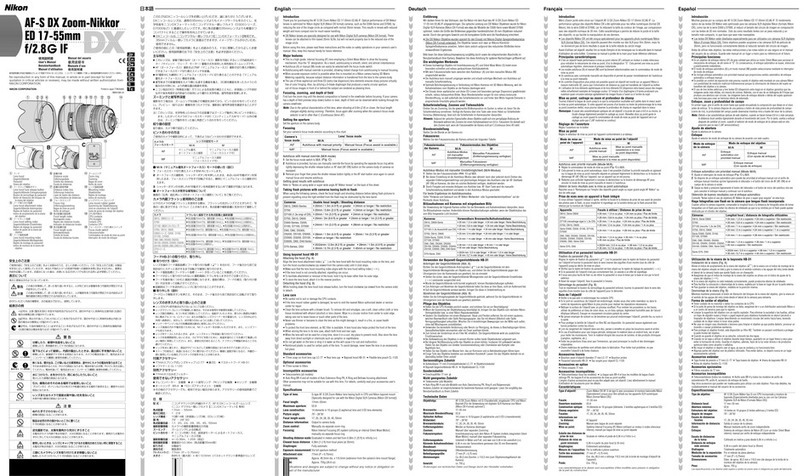
Nikon
Nikon AF-S DX Zoom-Nikkor 17-55mm f/2.8G IF-ED Operating instructions
Nikon
Nikon DS-U1 User manual
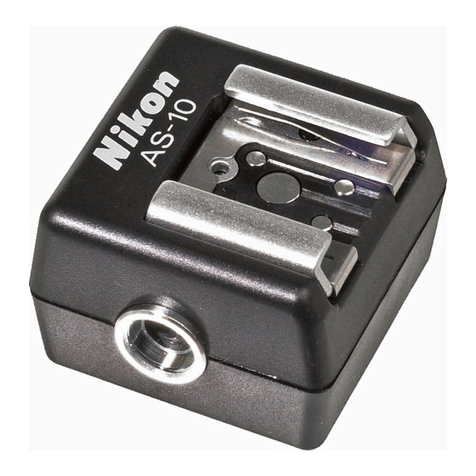
Nikon
Nikon TTL User manual
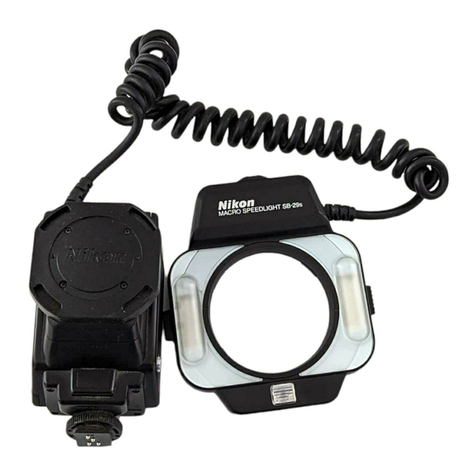
Nikon
Nikon SB-29 User manual
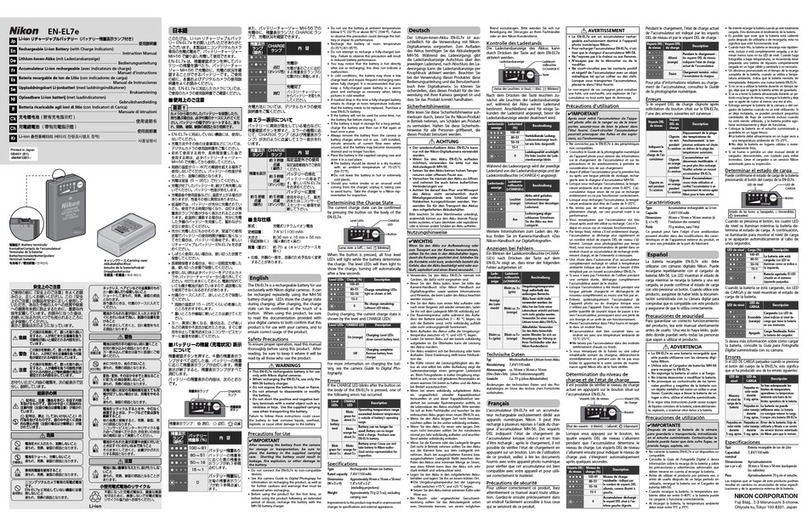
Nikon
Nikon EN-EL7E User manual

Nikon
Nikon MC-36 Instruction Manual

Nikon
Nikon EH SK-6A User manual
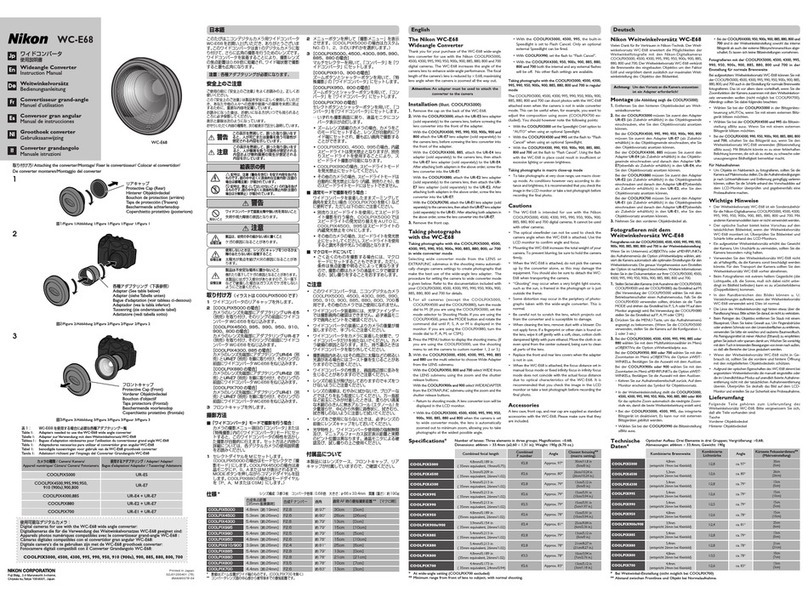
Nikon
Nikon WC-E68 User manual
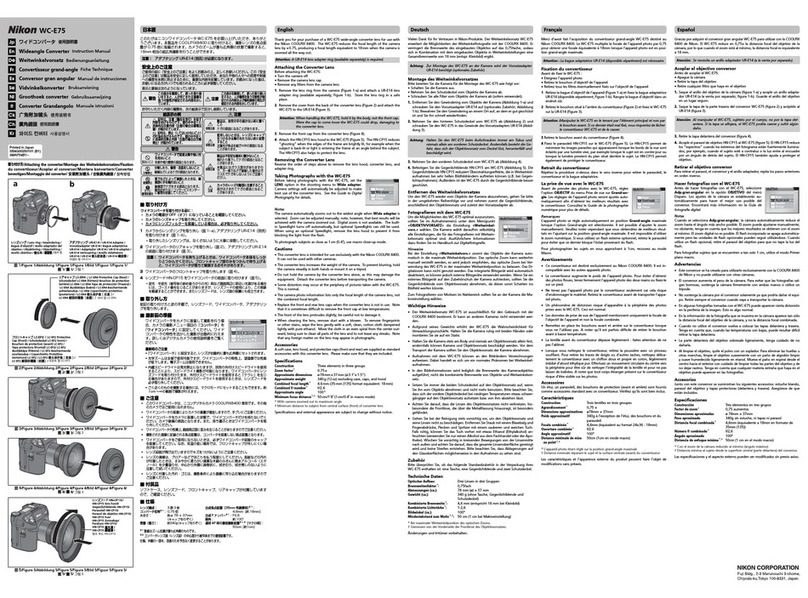
Nikon
Nikon WC-E75 User manual

Nikon
Nikon DK-17M User manual


